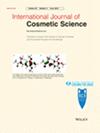Micellar solubility and co-solubilization of fragrance raw materials in sodium dodecyl sulfate and polysorbate 20 surfactant systems
Abstract
Objective
The aim of this work was to investigate the solubility and co-solubilization of fragrance raw materials (FRMs) in sodium dodecyl sulfate (SDS) and polysorbate 20 (P20) surfactant micellar systems, which can advance our knowledge of multi-solute micellar solubilization and fragrance olfactory performance from product matrices containing the surfactants.
Methods
The transfer of individual FRMs and binary FRM mixtures into micellar phases was quantified by UV–VIS differential spectroscopy and evaluated in terms of the standard Gibbs free energy change and micelle-water partition coefficient. Co-solubilization effects were further evaluated by the deviation ratio.
Results
Anionic SDS was found overall to be a more efficient solubilizer than nonionic P20. On an individual basis, micellar solubilization generally increased with solute lipophilicity but was additionally impacted by solute rigidity and steric effects. Micellar solubilization was favoured for more rigid structures and less favoured for FRMs that exhibited larger molecular rotation and steric hindrance. For multi-solute systems, three co-solubilization effects were observed: (i) inhibitive effect in which micellar partitioning of both solutes decreased, (ii) an inverse effect where partitioning of one solute increased while the other decreased and (iii) synergistic effect in which partitioning of both solutes increased. During co-solubilization in P20 micelles, many FRMs competed for solubilization between the polyoxyethylene chains in the outer layer of the micelle, thereby resulting in an inhibitory effect for both solutes. Co-solubilization of FRM binary mixtures in SDS micelles often resulted in a synergistic increase in micellar solubility, possibly due to micellar swelling, thereby facilitating partitioning of additional solutes into the micelle. An inverse effect in which the micellar solubility of one solute increased, while the other decreased was observed in both surfactant systems with varying degrees of partitioning depending on the composition of the FRM mixture.
Conclusions
The results of this study provide valuable insights into the impact of FRM composition on multi-solute partitioning behaviour and the impact of surfactant type on co-solubilization in micellar solutions.


 求助内容:
求助内容: 应助结果提醒方式:
应助结果提醒方式:


